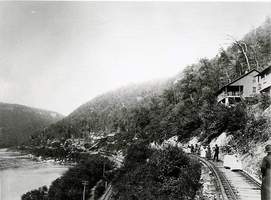
The study of the names of West Virginia places involves geography, as well as history, folklore, religion, biology, and language. In many cases place names evolved naturally and informally, from common use through the folk process. When done formally, names were chosen or approved by government officials, including the post office; by private companies, such as railroads naming their stations or mining companies naming their company towns; and by others. Scholars often can find accurate information about the sources of names given formally, but folk names are often hard to trace.
Plants and animals, including birds, are common sources of names in West Virginia; for example, Buffalo, Bass, Thornwood, Pineville, Blue Jay, Bob White, and Crow. Hydrological features, landforms, and geological structures provided names for places such as Rock, named for a cliff on the Bluestone River, while the river itself was named after the blue-gray stone that predominates in the upper reaches of its watershed. The communities of Lost River and Birch River are named for rivers. The towns of Hurricane and Tornado were named for weather phenomena. Besides White Sulphur Springs, there are many other West Virginia communities named after springs.
Many names reflect cultural elements or contemporary events. Some arise from national historic figures, such as Calhoun, Clay, and Webster counties; others from battles, such as Princeton, named for an important battle at Princeton, New Jersey, during the Revolutionary War. (And Mercer County, which Princeton serves as county seat, was named for Gen. Hugh Mercer, who died at the Battle of Princeton.) Other names remember persons of local importance, such as Bramwell and Parkersburg. Women are not forgotten, providing the names for Eleanor (for Mrs. Roosevelt), Belva, Jane Lew, and Arista, among others. Religious associations provide many names: Mt. Nebo, St. Marys, Corinth, Medina, New Vrindaban, and of course, Bethlehem. Asbury was named for Bishop Francis Asbury, a founder of the Methodist Church in America. Indian words, as well as fanciful European-American notions about Indians, are the source of names such as Naugatuck, Matoaka, Kanawha, and Pocatalico. Names borrowed from other places are common also and include London, Berea, and New Martinsville. Classical names include Troy, Egeria, Sabine, and Pliny.
An interesting group of place names are those formed by the combination of other names. For example, Kenova was named because of its location on the border of Kentucky, Ohio, and Virginia. Ovapa was named after Ohio, Virginia, and Pennsylvania. Sometimes the initials and the last name of a person were used to form a name, as Itmann from I. T. Mann and Elgood from E. L. Good.
Odd was named because the people running it wanted an unusual or odd name. Another settlement made a request for a post office, and the sender supposedly added a postscript saying, ‘‘we need a post office, that’s true.’’ So postal officials named it True. Some names reflect spelling mistakes, such as Lerona instead of Lenora. Philippi was named after Philip Barbour, not the Biblical city. It is the county seat of Barbour County.
There is a historical succession in naming, representing changing times and changes in prevailing authority, which is to say that names change. Native names were supplanted by those of early settlers of European descent, with many of those names themselves succeeded by names provided by later industrialists. A large part of the current place names of southern West Virginia were provided by the coal companies, including coal operator surnames such as Tams or Caperton and compound names such as Fireco or Ameagle. More recently, the tourism industry has brought its names with ski resorts naming mountain slopes and whitewater rafters renaming many features of the New River Gorge.
This Article was written by Raymond Thomas Hill
Last Revised on November 20, 2023
Sources
Janssen, Quinith & William Fernbach. West Virginia Place Names. Shepherdstown: J & F Enterprises, 1984.
Kenny, Hamill. West Virginia Place Names. Piedmont: Place Name Press, 1945.
Alotta, Robert I. Signpost and Settlers: The History of Place Names in the Middle Atlantic States. Chicago: Bonus Books, 1992.
Hill, Raymond T. "The Toponymy of the Lower New River." Proceedings of the New River Symposium. : 1990.
Hill, Raymond T. "Toponymy of Southern West Virginia." Proceedings, The Seventh Biennial Conference on Appalachian Geography. : 1992.
Cite This Article
Hill, Raymond Thomas "Place Names." e-WV: The West Virginia Encyclopedia. 20 November 2023. Web. 26 July 2024.


Comments?
There aren't any comments for this article yet.
Click here to read and contribute to the discussion →